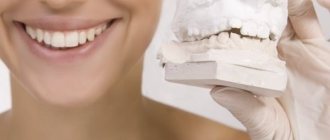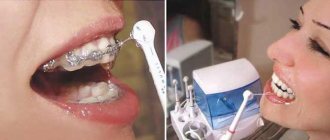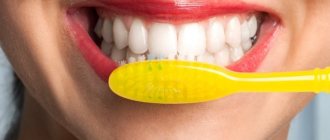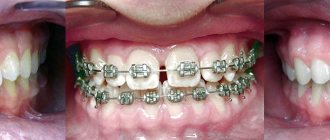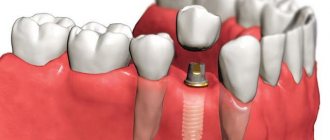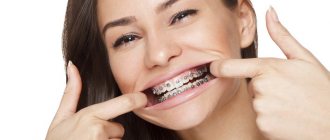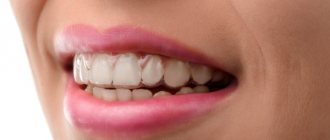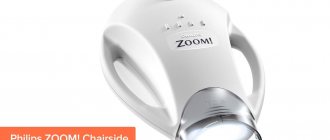648
There are many conflicting opinions expressed regarding the condition of the enamel after braces. Some people claim that braces damage tooth enamel and cause tooth decay.
Others argue that these orthodontic devices are completely safe for your teeth. The truth, as always, lies somewhere in the middle.
What's missing from a changed smile?
As a rule, by an ideal smile, orthodontic patients who have just embarked on a complex, long-term path of orthodontic treatment understand ideally evenly positioned teeth. And after the braces are removed, the reward really is an even row of teeth in the correct position. The more obvious become smaller, insignificant flaws, which previously simply faded against the background of crowded crowns turned in different directions.
The thing is that treatment with braces changes the location of the teeth, but is not able to change their shape and the color of the tooth enamel. No matter how the orthodontist moves the teeth, the smile will not become perfect if the teeth have certain defects.
The aesthetics of the dentition is impaired by:
- chips;
- darkened areas, yellowed enamel;
- pathologically worn cutting edges of the central incisors;
- lack of symmetry of teeth located in the smile zone;
- small interdental gaps;
- asymmetrical edges of teeth subjected to separation (grinding) during the correction of crowded teeth with braces.
Unfortunately, not all orthodontic centers in Moscow plan the process of bite correction together with specialists in the field of aesthetic dentistry. And not in all cases, dentists will be able to tell during a preliminary consultation whether the patient will need correction or not.
Therefore, some lucky people who have had their braces removed are disappointed with the results at the end of treatment: their expectations of a Hollywood smile were not met, and they were not ready for the next financial investment.
Kinds
Teeth whitening is done in several ways. The doctor selects a specific method, depending on the patient’s age and the condition of his tooth enamel.
Here is a list of the most popular methods:
- special strips;
- gels and mouth guards;
- photobleaching;
- Air Flow;
- laser whitening.
It should be taken into account that in adolescents the skeletal system is still in the formative stage, and in older people the enamel is often very worn out.
Stripes
They are coated with a multicomponent gel, which contains bleaching agents. In most cases, the main component is hydrogen peroxide. The strips remove the yellowish tint of teeth and return them to their natural color. They are used at home. The products are manufactured by several companies. There are options for gentle, standard and powerful whitening.
Whitening strips are very easy to use
Gels and mouth guards
This procedure is considered to be easily accessible. It can be done either at home on your own or in a dental clinic. Many manufacturers have ready-made kits. The gels may contain the following substances:
- carbamide peroxide;
- soda or alkali;
- hydrogen peroxide;
- acids;
These components are present in concentrations that do not have an aggressive effect on the enamel. The drugs are used in combination with mouth guards. The latter are pads that need to be put on the teeth for exposure to the whitening gel.
There are three types of caps:
- Standard. They are made according to standard parameters, you need to select your size.
- Individual. Made to order based on the patient's impression.
- Thermoplastic. They are able to change their shape under the influence of heat. After heating the device and pressing it to the jaws, the resulting product exactly repeats the shape of the jaw arch and teeth.
Whitening products are available in syringes or tubes. The gel is kept for a certain period of time, which is indicated in the instructions. Next, the mouth guard is removed and the mouth is rinsed.
Advantages of the method:
- low price;
- ease of use.
Flaws:
- many contraindications;
- violation of the enamel structure (if used incorrectly).
Photobleaching
This method is widely in demand in modern dentistry. A gel containing hydrogen peroxide is distributed over the surface of the teeth. Then, the exposure is carried out with a halogen, LED or ultraviolet lamp. As a result, active oxygen is produced, which removes pigments from dental tissues.
Advantages of photobleaching:
- uniform lightening;
- instant results;
- no discomfort during manipulation;
- high degree of security;
- possibility of repeated execution (up to 6 times);
- efficiency;
- minimum contraindications;
- affordable price.
Flaws:
- duration of the procedure (more than two hours);
- the effect does not last long (for 6 months);
- increased tooth sensitivity.
Air Flow
This is a hardware procedure that allows you to lighten the enamel by one or two tones. A jet of water containing abrasive powder is applied to the surface of the teeth under pressure.
Advantages:
- painlessness;
- safety;
- the ability to clean even the most difficult to reach areas;
- absence of dental hypersensitivity after manipulation.
Flaws:
- there are contraindications (allergy to the components of the polishing mixture, bronchial asthma, diabetes mellitus and others);
- Dense old tartar is not removed.
Is it possible to change the situation?
1. If desired, bringing your smile to perfection will not be difficult and will not always require significant investments. After all, the first, most important, most necessary stage has already been completed. Orthodontic treatment corrects your bite, straightens your teeth, and prevents more serious dental problems. And modern methods of artistic (or aesthetic) dental restoration will help restore the aesthetics of the dentition.
2. Adults are able to solve the dilemma themselves: whether to continue treatment if they don’t quite like the smile, or limit themselves to the achieved result.
What methods are used to correct the dentition after braces?
- Due to the inability to carry out hygienic cleaning while wearing braces, teeth can noticeably change color. Teeth whitening after braces can help get rid of unpleasant yellowish or gray tints and dark spots.
- If everything is in order with the functionality of the teeth, then indirect and direct methods can be used to restore their aesthetics.
- The quickest way is to restore a tooth using the direct method - by correcting the shape of the dental crown by layer-by-layer application of photopolymer materials of carefully selected shades. Photopolymers are most often used to correct the uneven cutting edge of the central incisors.
- Indirect ones will require several visits to the doctor. The shape of the tooth will be corrected using an individual microprosthesis made from an impression - a veneer or lumineer, glued with dental cement to the prepared tooth surface.
Whitening after braces at home
You can achieve excellent results while sitting at home. In this case, it is effective to use the following methods:
- Gels with a whitening effect that allow you to achieve long-term preservation of the results.
- Constant oral hygiene allows you to eliminate plaque, as well as the initial stage of tartar formation. Cleaning should occur within 15 minutes. To do this, you need to use flox and rinse after meals.
- Cleansing tooth enamel using a DIY composition. It is very effective to use crushed dry sage leaves. This product allows you not only to whiten tooth enamel, but also to create a protective layer that protects your gums from the influence of bacteria.
Gels and mouth guards
Gels are used for high-quality whitening. In most cases, their composition assumes the presence of hydrogen peroxide. As a rule, cleansing occurs with the help of drops. Expensive models are produced according to individual parameters, so they exactly follow the shape of the teeth. Inexpensive mouthguards are produced in standard parameters; their selection is carried out taking into account the size of the jaw.
The use of drops and gel are very easily accessible treatments. You just need to apply the compositions and put them on your teeth for the specified time. Gels can also be used at home. Their composition assumes the presence of an active component - perhydrol, but in small quantities. Potassium nitrate can also be used.
Successful combination - peroxide and soda
Teeth whitening after braces can be done at home. To do this, you can try the following composition: 1 dessert spoon of soda and 3% hydrogen peroxide. The resulting composition should have the consistency of a paste. Use the product as a daily toothpaste. The duration of one cleaning is 3 minutes. After this, you should rinse your mouth thoroughly. You can use this technique only 2 times a week. You will be able to see the desired result after the first use.
Lemon
Everyone has long known that lemon contains ascorbic acid. This is what is so necessary for the normal functioning of connective and bone tissue. This component is an antioxidant that has biologically active L-ascorbic acid. It is most often called vitamin C. Its benefits are obvious not only for the gums, but also for the entire body.
How to whiten with lemon? There are many options for using lemon. The simplest one is to treat tooth enamel with a slice of lemon. You can also use a crust without pulp. After this manipulation, be sure to rinse your mouth to remove excess ascorbic acid.
You can add a couple of drops of lemon juice to your regular toothpaste. Such measures will make tooth enamel lighter and also combat bleeding gums. To get rid of plaque in the spaces between your teeth, chew a slice of sour fruit with a crust for several minutes.
The methods provided for obtaining a Hollywood smile should not be used very often. This especially applies to people suffering from hypersensitivity of tooth enamel. It is enough to perform the procedures once a week.
When performing teeth whitening at home, you need to understand that teeth are extremely sensitive. Therefore, you need to be very careful when choosing an at-home whitening option. Do not overuse salt, soda and peroxide. It is allowed to replace acids with fresh strawberries or wild strawberries. You can make a puree based on these berries.
Features of teeth whitening after braces
After wearing braces, only professional whitening methods performed exclusively under the supervision of a qualified dentist can be used. This is explained by the fact that the enamel was subjected to significant stress during treatment by the orthodontist. At least a month must pass from the moment the bracket system is removed before it can be restored to its color. Teeth need to be given time to restore and strengthen the enamel, because whitening will become another stress for it.
The dentist will definitely take this point into account and select the concentration of the active elements of the whitening composition so as not to cause damage to the mucous membrane and not reduce the quality of the tooth enamel. In many cases, full-fledged whitening can be completely replaced by Air Flow cleaning, which effectively removes plaque and restores the natural shade of teeth.
| Doctor: Sudzhaev Sergey Romanovich Patient age: 25 years Diagnosis: distal occlusion, transversal incisal occlusion, crowding of the frontal sections of the upper and lower dentition, edentulous teeth 1.4;2.4;3.4;4.4. Duration of treatment: 12 months Equipment: Clarity SL bracket system | TO THE DOCTOR |
| BEFORE | AFTER |
How to find us?:
Moscow, Spartakovskaya Square, 14, bldg. 2 (entrance from Baumanskaya St., 13, bldg. 3)
Be patient
Many patients, who are ready to amaze the world with their truly snow-white and dazzling smile after removing braces, almost panic when they see darkened spots on their teeth and immediately intend to carry out the whitening procedure. You should not rush; you will need to wait at least a month, or even more, for the tooth enamel to return to normal and recover after wearing braces. Moreover, it happens that after some time it returns to its usual appearance on its own and bleaching becomes an absolutely unnecessary operation. In addition, you should always remember that its action is based on a chemical reaction, which is aggressive in nature; you should weigh everything well and think it over before exposing your teeth to such effects.
Beautiful and smooth! Teeth after removing braces
Crooked teeth not only spoil the aesthetic appearance. They can lead to poor health because they do not chop food well. to correct an overbite and achieve a beautiful smile.
Once the braces are removed, the treatment does not end. Weakened enamel that needs to be strengthened, wearing retainers, and teeth grinding are just a drop in the bucket compared to how many types of care your teeth need after wearing products.
Whitening – is it worth doing or is it better to wait?
The use of aligners, braces, other retainers and other corrective structures often causes the effect of yellowing of the enamel after aesthetic restoration. There is a desire among patients to undergo whitening. But experts do not recommend it - manipulation can negatively affect the health of the oral cavity. The subsequent installation of additional devices on the teeth also does not contribute to the procedure.
After removing all corrective devices, you should consult with your treating orthodontist and only then do the following:
- Whitening using special strips.
- Whitening that requires the use of a laser.
- Cleaning, which allows you to mechanically remove the formed stone.
- Remineralization when using new special toothpastes enriched in their composition. Minerals are able to penetrate into the bone structure of the tooth through toothpaste. The enamel becomes stronger and whiter. But, it is necessary to choose the right toothpaste - after all, everything that it contains will be absorbed into the bone structure.
- An additional positive point from the manipulation of cleaning with special means is getting rid of the glue that fixes the structure.
You need to be careful with folk remedies. Patients often use them at home to restore their smile's whiteness and attractive appearance. Despite a certain effect, they can negatively affect the enamel - thinning or compromising its integrity.
It is strictly forbidden to use salt, peroxide or soda to achieve a white color. Only manipulations by a specialist will help restore teeth professionally, competently and with maximum effect after wearing and removing braces, and giving them a white color. By contacting the doctors at the Med-stom clinic, you can restore the correct position of the dentition, and by visiting several procedures, remove plaque and dark stone. If necessary, veneers or lumineers can be installed to help with enamel.
All these manipulations will be performed simply and quickly by the doctors of the Med-stom clinic
Teeth after removing braces: installing retainers to secure the result
This is an important procedure that should not be abandoned. After removing braces, the teeth are not yet sufficiently strengthened in their new position, and if there is no support, they may return to their original place .
Then there will be no benefit from wearing braces for a long time. Retainers are removable and non-removable .
The first option is more convenient to use, but whether or not it can be installed is up to the dentist to decide, taking into account the characteristics of the previous treatment and the degree of its complexity . Removable products must be worn at night, and, if possible, worn during the day. Retainers are available in different designs: in the form of a plate, a bracket, or even a transparent mouthguard .
Duration of wearing retainers
It is necessary to take into account that after removing braces, you will have to fix retainers on your teeth for some time. The time of the procedure depends on associated symptoms, such as:
- Patient's age. Young people need retainers for a short period of time. Adults will have to endure this procedure longer.
- There is a direct relationship between the duration of wearing braces and the time of fixation of retainers. The longer some were endured, the longer others would have to endure.
- Individual characteristics of the body. It all depends on collagen, bone and cartilage structures. Their strength and usefulness in structure and composition allow them to respond more effectively to any attempts to change position. Those whose bone remineralization proceeds correctly in the body will have to experience less prolonged exposure to both braces and trays, tapes, and other types of structures.
When a patient has an incorrect bite, braces alone will not work. You will have to use additional corrective devices that are fixed in the mouth - on the gums and dentition. This is what they use.
What is put after braces?
Correcting the bite with braces is very effective in correcting almost any abnormality. The process of giving teeth a normal position is quite long and requires a lot of patience. And finally, the day comes when the dentist decides that the active phase of treatment is over and the braces can be removed, to the great joy of the patient. However, many people do not know that orthodontic treatment does not end once the braces are removed.
The movement of teeth that occurs while wearing braces is accompanied by active restructuring of the jaw bone tissue, ligaments, blood vessels and other periodontal tissues. After the braces are removed, the teeth retain a certain degree of mobility and tend to return to their original position. Therefore, they need additional fixation. For this purpose, special orthodontic structures are used - retainers.
How to restore enamel after braces
After removing the braces, it is necessary to carry out restorative procedures for the tooth enamel. There are several effective ways to strengthen it and eliminate marks from the structure. Let's take a closer look at each of them.
Strengthening compounds
These preparations contain vitamins and minerals that have a positive effect on the condition of dental and periodontal tissues. Here is a list of the most common ones:
- Asepta. The main component is coral calcium, which effectively restores dental tissue.
- DentoVitus. Contains retinol, vitamin E, ascorbic acid, copper, calcium and other beneficial substances. Promotes active regeneration of bone tissue.
- Kaltsinova. Significantly increases the strength of teeth.
- Rox. Effectively cleans plaque and reduces enamel sensitivity.
All products are used according to the attached instructions.
Mechanical cleaning
The procedure is carried out using a dental curette. This method removes only mineral deposits. In recent years, the method has lost its relevance due to numerous shortcomings. Here they are:
- soreness;
- risk of damage to enamel and gum tissue;
- duration of the procedure.
In modern dentistry, rotating power tools and special pastes have been used for cleaning.
Laser whitening
This technology allows you to quickly and effectively remove plaque and make your smile snow-white. A mixture of hydrogen peroxide is applied to the teeth. It is activated by a laser emitter.
Advantages of the method:
- safety;
- long lasting effect;
- speed of the procedure;
- high efficiency;
- prevention of caries.
Disadvantages include painful manipulation. In addition, there is a risk of damaging the bone structure.
Microabrasion
The method involves special abrasive treatment of the enamel. A polishing composition containing the following substances is applied to the teeth using a rotating nozzle:
- hydrochloric acid;
- silicon;
- carborundum.
Advantages of microabrasion;
- safety;
- painlessness;
- ease of implementation;
- low price;
- preventing the development of caries at the initial stage.
Condition of enamel before and after microabrasion
But there are many contraindications to performing this procedure. Here is their list:
- pregnancy and breastfeeding;
- enamel hypoplasia;
- fluorosis;
- cracks in the enamel.
Special stripes
They contain active bleaching agents (mainly hydrogen peroxide). The latter penetrate deeply into dentin and enamel, discoloring the pigments they contain. There are three options for strips - soft, medium and enhanced. They are used only after preliminary completion of the remineralization procedure.
Composite restoration
The method is used in cases where other methods have proven ineffective. The defective part of the tooth surface is coated with a photocurable polymer. Advantages of composite restoration:
- speed and simplicity of the procedure;
- aesthetics;
- affordable price.
The disadvantage is that there is a risk of staining the composite.
Composite dental restoration
Veneers
A layer of damaged enamel is removed from the defective tooth and a veneer—a thin ceramic plate—is glued to this place. It is identical in color and shape to the tooth surface.
Advantages of the method:
- impeccable aesthetics;
- plate resistance to staining;
- strength.
It should be noted that this method is the most expensive. It is not advisable to use veneers for the restoration of lateral dental units.
After removing braces, you must use one of the methods for restoring tooth enamel. It will strengthen and begin to fully protect straightened teeth.
What are retainers?
Patients often ask dentists: “Is it necessary to use retainers after treatment with braces?” The answer is yes. If during the recovery period after wearing braces no measures are taken to fix the teeth, then they may simply return to their previous incorrect position, negating all the results achieved. Therefore, the use of retainers at the final stage of orthodontic treatment is mandatory.
Retainers are removable and non-removable. Removable retainers are made in the form of a wire arch, plate or clear plastic tray. In the first months after installation, they must be worn constantly, removed during meals. In the future, after the doctor's permission, removable retainers can be worn only for a certain period during the day, for example, at night. However, using only removable structures is not always advisable. This issue is decided by the attending orthodontist, taking into account the shape of the abnormal bite, the individual characteristics of the body, the course of the active stage of treatment with braces and other factors.
A permanent retainer is a curved thin wire of the required length that fixes the teeth and restrains their desire to return to their original position. This design is usually attached to the back surface of the teeth using an adhesive. It is made individually, so it is comfortable and invisible. Fixed retainers are most often used in orthodontics because they are more practical and do not interfere with your normal lifestyle. They are usually installed immediately after braces are removed or even a few days before, in order to immediately fix the teeth in the achieved position.
The most effective is the combination of fixing teeth with a permanent retainer and using removable plastic aligners at night. This approach allows you to maximize the results of orthodontic treatment. It is worth noting that while wearing retainers, the patient should pay sufficient attention to oral hygiene and regularly have professional teeth cleaning at the dental clinic.
The most effective ways to remove marks on teeth
So, while you are wearing braces, you need to pay proper attention to hygiene to avoid the problem of stains after the braces are removed. But if a situation arises, the doctor can offer several solutions at once.
The method is selected based on the individual characteristics of the patient and the specific problem: the doctor removes glue from the teeth, grinds, polishes, prescribes remineralization therapy, performs fluoridation and whitening procedures, professional teeth cleaning, fills or restores tooth enamel, and prescribes vitamin complexes.
Professional teeth cleaning
Professional teeth cleaning should be carried out at least once a year for preventive purposes. If you are a wearer of braces, then you simply need this procedure, since it allows you to better remove plaque and hard stone. In addition, after removing braces, this is the first thing that should be done to restore the enamel. Professional hygiene will allow you to return the enamel to its natural shade and even get rid (at least partially) of dark spots.
Expert opinion
“The soft plaque on the teeth hardens in less than a day; such hard deposits cannot be removed with a regular toothbrush. When wearing braces, the problem is aggravated, since it is very, very difficult to clear tight spots. If you even sometimes neglect to clean your mouth, the amount of hard plaque will steadily increase and you cannot do without professional cleaning.” Igor Slyudov, orthodontist with over 17 years of experience.
Fluoride-containing drugs
To strengthen weakened enamel after removing braces (however, the procedure can also be carried out during orthodontic treatment), it is recommended to brush your teeth with fluoride-containing pastes. After the devices are removed, dental fluoridation has a positive effect: a fluoride-containing gel or varnish is applied to the enamel surface over a course of one and a half to three months, which saturates it with vital elements. The procedure is repeated for fifteen minutes at certain intervals, depending on the initial picture, from 4 to 15 fluoride application sessions can be carried out.
Fluoridation is aimed at restoring the mineral composition of hard tissues, strengthening and reducing tooth sensitivity, reducing the risk of developing caries (by more than 60%), and protecting enamel from negative influences.
Remineralization of teeth
Remineralization includes a whole range of procedures: damaged areas of enamel are first ground off and then covered with a solution that penetrates deeply into the tissues and saturates them with minerals. The complex also includes fluoridation, but in addition to strengthening teeth from the outside, doctors recommend healing the body from the inside - starting to take vitamin and mineral supplements with a high content of calcium and fluoride. The drug must be taken for at least a month, then take a break and repeat if necessary.
Enamel whitening
Important! Due to weakening of the enamel, whitening procedures should be carried out no earlier than a month after removing braces. Before manipulation, you need to wait until the dental tissues are completely restored. Bleaching should be preceded by careful professional hygiene, fluoridation and remineralization.
The procedure is not indicated for all patients who have had their braces removed. After all, any whitening is stress for the enamel. But if you cannot do without it, then it is better not to use home methods, but to resort to professional whitening using gels activated by special lamps. Under the supervision of a doctor, the procedure will be safer and more effective; in addition, it can change the shade of the enamel up to 10-12 tones.
Teeth whitening and restoration with retainers installed
After removing the braces, professional teeth cleaning : the dentist removes the remaining adhesive that attached the braces to the teeth and polishes the enamel. The surfaces to which the retainer will be attached must be completely free of any dental deposits. At the request of the patient, a whitening procedure can be performed, but it can also be performed later at any time. The same applies to the restoration of teeth from the vestibular (external) and approximal (lateral) surfaces; if necessary, it can be carried out without any restrictions. Whitening and restoration do not affect installed retainers in any way, since these orthodontic structures are located on the oral (inner) side of the teeth.
The process of restoring enamel after splinting
Since braces and retainers remain on the surface of the tooth for many weeks and are constantly in contact with tooth enamel, it is necessary to exercise very careful oral hygiene. But this is difficult to do. And not everyone has the hard work and patience to carry out all the manipulations correctly and carefully. In addition, the treatment period can last from 8 months to 3 years. As a result, the enamel is at least weakened, and in the worst case, cracks, plaque, tartar, or even chips appear on it.
In order to prevent changes in the appearance of the enamel, it is necessary to carry out hygienic cleaning of the oral cavity very carefully, in compliance with all the rules. Moreover, it is necessary not to forget about cleansing the inner surface of the cheeks and tongue, since bacteria develop on them that can cause negative processes on both the teeth and gums.
When braces are removed, experts recommend using gels, varnishes or pastes to cover the outer surface. In this case, it is possible to achieve a significant reduction in sensitivity and a decrease in the risk of caries formation at the site of microcracks.
Sometimes patients turn to specialists to have their teeth professionally cleaned. This is a successful solution to many problems, as a specialist performs an application, removes pigment spots, and cleans off plaque.
What and how to remove braces - Stages
The procedure for removing braces is carried out by the attending orthodontist. Removing the system from the teeth has the following stages:
- Preparation for removal;
- Removing braces;
- Restoring the appearance of teeth;
- Treatment with retainers.
Preparation includes making an appointment with a doctor and performing professional oral hygiene. The procedure for removing braces from teeth is that each bracket is grabbed with special pliers and bitten off the surface of the tooth. The manipulation is carried out slowly, and the braces are carefully separated from the teeth.
When biting braces, some unpleasant sensations are possible due to slight pressure on the tooth. All braces, ligatures, orthodontic arches and additional elements of the system are removed one by one. After removing the orthodontic structure, the appearance of the teeth is restored.
Very often, particles of adhesive material may remain on the teeth; it is cleaned off and the teeth are polished using brushes. If pigmentation is present, teeth are polished. If chalky stains or caries have formed on the teeth, they are treated with remineralizing therapy or filling. It should be noted that caries occurs very rarely with low levels of hygiene and poor dental care.
The effect of locks on the protective coating of the tooth
Braces do not directly contact the tooth enamel. Between them and the tooth there is a layer of adhesive.
It contains fluorine, which has remineralizing properties in relation to enamel. That is, the brace not only does not destroy the enamel, but even helps to strengthen it.
Then how can one explain the appearance of stains on teeth after treatment with braces? This fact is not made up. According to research by 3M, white spots on enamel actually appear quite often - in 13-75% of cases.
The thing is that stains on the enamel and the initial signs of caries appear not under the lock, but around it. And there are certain reasons for this.
How long does it take to remove braces?
Removing braces is a shorter and less complicated procedure than installing a braces system. The manipulation lasts about 15-30 minutes. Restoration and treatment of teeth may be included in the procedure for removing the system or may be carried out at the next visit, as it requires additional time from the doctor.
The procedure for removing an orthodontic structure from the inside is more complex and takes 30-40 minutes. Lingual braces are a bit difficult to access and require more time. This arrangement of braces has its advantages - the system is not noticeable, but for the doctor’s work it is more labor-intensive. This explains the higher cost of hidden braces.
Clinic offers
Most dental experts agree that teeth whitening after wearing braces requires a professional approach, for which you need to go to a specialized clinic after a month has passed since the removal of the orthopedic structure.
Most often, a hardware procedure is performed in a dental clinic to restore the natural shade of AirFlow.
During this procedure, a stream of water containing abrasive powder (sodium bicarbonate) is applied to the surface enamel. Due to this, age spots and soft plaque in the interdental spaces are removed.
It must be borne in mind that this procedure is allowed to be carried out only 30 days after the removal of orthodontic structures. Its result will be lightening by 1 or 2 tones.
If necessary, the following types of professional whitening can be used:
- photobleaching (using ultraviolet, LED or halogen lamps);
- procedure using a laser beam;
- using the ZOOM technique.
Photobleaching
This procedure involves the use of a gel based on hydrogen peroxide. It is activated with the help of lamps, due to which the release of oxygen causes deep penetration into the dentin structure. This provides a brightening effect.
The most commonly used methods are:
- Beyond Polus. Therapeutic effectiveness is achieved through a combination of 2 types of radiation (LED and halogen).
- Luma Cool. The second name is the cold method. Only an LED lamp is used, which activates the gel composition for 8 minutes.
Photobleaching procedures are performed in compliance with the following algorithm of actions:
- First, a complete sanitation of the oral cavity is carried out. If necessary, old fillings are replaced.
- To protect your eyes, wear safety glasses and install a retractor.
- After applying the gel, the lamp is turned on to activate the oxygen release process. Depending on the technique, its effect lasts from 10 to 20 minutes.
- Upon completion of the procedure, the oral cavity is cleansed of any remaining gel.
- If necessary, manipulations can be repeated up to 6 times.
You need to know that after any type of this procedure you should follow a diet that limits the consumption of foods and drinks that have a coloring effect.
Advantages and disadvantages of photobleaching.
| Number in order | Main advantages | Negative points |
| 1 | No discomfort | Sometimes there is increased sensitivity to hot or cold foods |
| 2 | Proper procedure ensures a high degree of safety | Lack of effect in case of fluorosis |
| 3 | Minimum contraindications | Prolonged exposure to a dental unit causes pulp necrosis |
| 4 | Visible results after one session | There is a list limiting the possibility of carrying out the procedure |
| 5 | According to the Vita scale, you can achieve 12 shades of lightening in one visit | _ |
| 6 | Low cost compared to other methods | _ |
Application of laser radiation
The therapeutic effect of laser radiation is based on its combination with a special gel composition with hydrogen peroxide.
The procedure has the following stages:
- A special gel is applied to the front row of the upper and lower incisors. The inner surface of the lips and soft gum tissues are coated with a protective composition.
- Each unit is treated with a laser to activate the chemical composition of the gel.
- In order to consolidate the effect, fresh gel is applied after cleansing.
The duration of one session takes up to 45 minutes.
When restoring the natural whiteness of surface enamel using the laser method, the following advantages are noted:
- the session takes no more than 1 hour;
- the effect lasts up to 5 years;
- the action of the laser beam is accompanied by an antibacterial effect;
- you can achieve lightening by 8-10 tones;
- Due to the ability to act locally, the whitening effect becomes uniform.
The negative aspects of this technique include:
- high price;
- the possibility of an increased reaction to food with a high or low temperature in the first days;
- inability to lighten fillings on the frontal incisors of the lower and upper rows.
ZOOM
Restoring the natural shine and natural whiteness of the teeth after removing the braces can be done using a whitening procedure using ZOOM technology.
The main role is played by a special composition, which includes carbamide peroxide and hydrogen peroxide. To activate it, a lamp is used that studies ultraviolet rays.
The procedure is performed in a similar way to laser whitening, with the difference that the gel is activated by an ultraviolet lamp. To ensure that the effect is visible from the first session, the manipulation is repeated three times.
Practitioners warn that after ZOOM whitening it is necessary to adhere to a “white diet” (do not consume foods that change pigmentation). In addition, the food consumed should not be too cold or hot.
A stable effect, a high degree of safety, and a short recovery period are the main advantages of using the ZOOM complex.
But besides this, there are a number of restrictions that occur in the following situations:
- if the patient is under 18 years of age;
- when one of the chemical components of the gel is an allergen for humans;
- any trimester of pregnancy, and the period when a woman feeds her baby with breast milk;
- lack of complete sanitation of the oral cavity;
- the presence of oncological formations of the oral cavity;
- pathologies of a psychoneurological nature.
Watch the video to see how professional teeth whitening takes place.
Does it hurt to remove braces?
Almost all patients are interested in the question: is it painful to remove braces from teeth? The answer will be - it doesn’t hurt. During manipulation, discomfort may occur, but not pain. This is due to the long and strong fixation of braces. During the procedure, the doctor creates slight pressure on the tooth to separate the clasp from the surface of the tooth. This is what the patient will feel.
Review (Igor, 20 years old): “I had my braces removed a week ago. I want to say that it doesn’t hurt to remove it, but cleaning your teeth from glue is not very pleasant! Maybe it’s my sensitive enamel, but it hurt. The orthodontist promised to restore the enamel. But the main thing is that my teeth are straight, now I wear a retainer.”
Reviews
Most of the positive reviews belong to procedures that are performed in a dental clinic. This is due to the fact that a professional approach ensures an appropriate level of safety when performing the manipulation.
You can leave your reviews and comments in this article.
If you find an error, please select a piece of text and press Ctrl+Enter.
Tags: braces vestibular braces
Did you like the article? stay tuned
Previous article
Is it possible to smoke while correcting the bite with braces?
Next article
Teethxpress implantation – beautiful teeth in just 3 days
Restoration and teeth whitening
After removing braces from teeth, everyone expects to see a snow-white and beautiful smile. Unfortunately, very often after treatment it is necessary to carry out additional procedures for restoration or teeth whitening. After removal of the system from the oral cavity, small gaps may remain between the teeth, darkening or changes in the enamel, stains, and caries.
Dental restoration will help solve the problem of hard tissue deficiencies. With its help, you can eliminate enamel defects, various stains, caries, cracks, and chips of enamel. This procedure is a filling of teeth with special materials in order to restore the aesthetic appearance of the tooth, color and anatomical shape.
Teeth whitening is a very popular dental procedure that will make your teeth several shades lighter. Whitening has many contraindications: gum disease, caries, tooth sensitivity, gum recession, chips and cracks of enamel, hyperesthesia, wedge-shaped defects. It should be noted that wearing braces will not make your teeth darker and the procedure is not mandatory. You need to know that after whitening once, you will need to repeat the procedure every six months.
The topic of the safety of teeth whitening remains controversial in dentistry; every doctor has his own opinion. Even the safest drugs produce some damage to the enamel structure, after which it is necessary to carry out a course of mineral applications on the tooth enamel. If teeth are not restored with minerals, the enamel will become more fragile, quickly become saturated with food pigments and change color.
Restoration of teeth after wearing braces
As a negative side effect, cracks or, worse, chips in the bone structure may occur. If the problem is not addressed, it may get worse. The patient develops caries at the site of damage, and then the process goes even further. If you ignore the situation, a person may simply lose a unit of the series.
For these reasons, it is necessary to carry out restoration in a timely manner. There are a certain number of methods. Each is used depending on the needs of the patient and the situation occurring in the oral cavity:
- Functional, allowing to restore lost parts of the tooth or increase their function of chewing and grinding food.
- Aesthetic – creating a more attractive appearance.
- Combined - combining the first two options.
Consequences
When treating irregular teeth with braces, you must strictly follow all the doctor’s recommendations and follow the stages of treatment. After removing the structure from the teeth, there must be a retention period to record the results of the treatment. The consequences of removing the system from the teeth can be a little scary, since everyone expects to see a Hollywood smile, but it needs a little more work.
Feedback (Ekaterina, 19 years old): “I now wear braces and am really looking forward to having them removed. I am very worried about how my teeth will look and how the enamel will not deteriorate after treatment. The doctor said that removing the braces won’t hurt and I already want to do it quickly. True, you still need to wear the retainer for some time, I plan to put the retainer on my teeth in the form of a wire, it doesn’t need to be removed and it seems to be more effective.”
Due to long-term difficult access to some areas of the teeth, disturbances may occur in the form of: stains, glue residues, pigmentation, gaps. Such consequences do not occur often, but are the norm and can be eliminated with dental treatment.
Dental care after braces
After removing braces, most people maintain the good habit of taking very good care of their teeth. For care you will need a toothbrush, toothpaste, dental floss and mouthwash. You can brush your teeth as usual: twice a day, morning and evening. Dental floss should be used daily before bed to clean the spaces between teeth.
The mouthwash should be used throughout the day and before bed. If there is a retainer on the inner surface of the teeth, it is necessary to pay attention to this area of the teeth. The design is much smaller in size than braces, but it is also a food retention point and requires careful care.
Accessories for hygiene
Cleaning tooth enamel while wearing braces involves the use of the following special products:
- Orthodontic V-shaped brush for more effective cleaning of dental surfaces.
- Brush-brush (single-tuft) for cleaning the spaces between the tooth surfaces and the orthodontic arch of the bracket system.
- Dental floss for thorough cleaning of interdental spaces.
- Irrigator for washing out food particles and massaging gums.
- Toothpastes high in calcium and fluoride, which help strengthen enamel.
- Antiseptic rinses.
